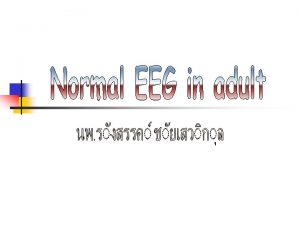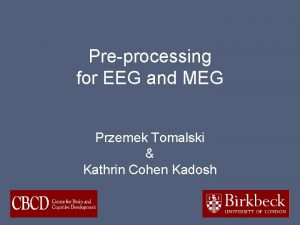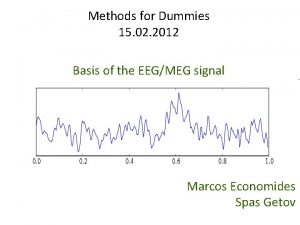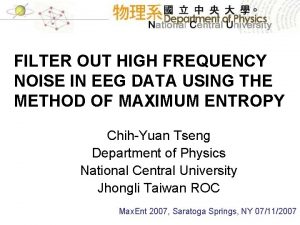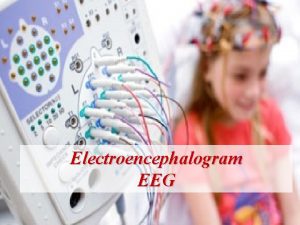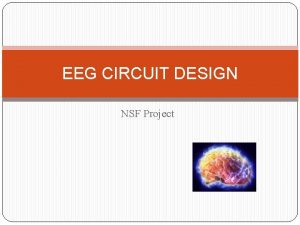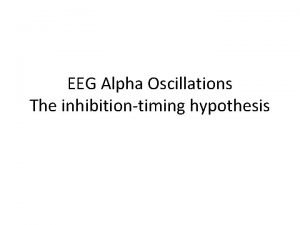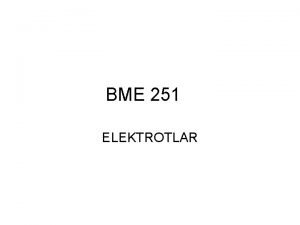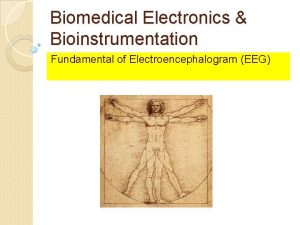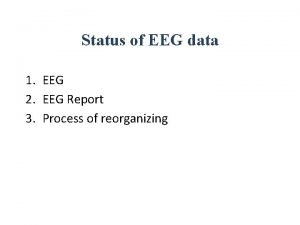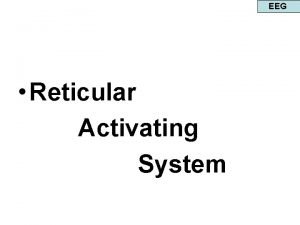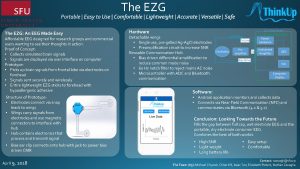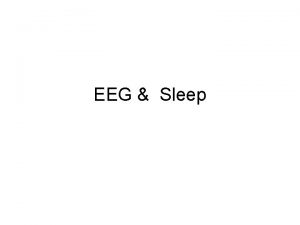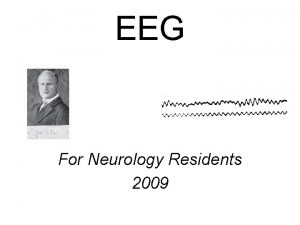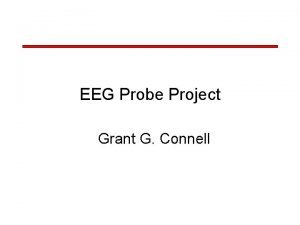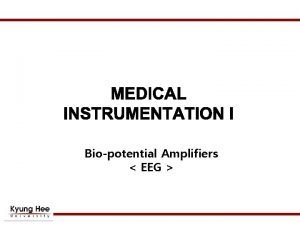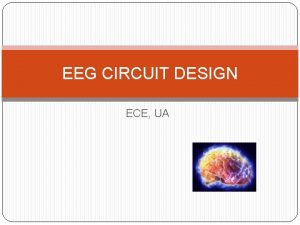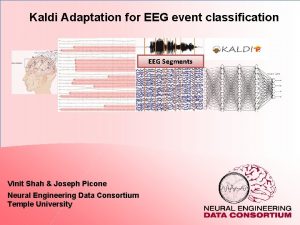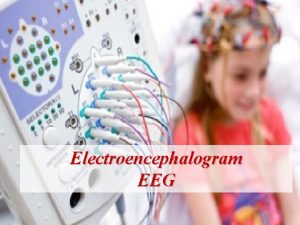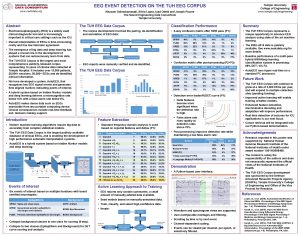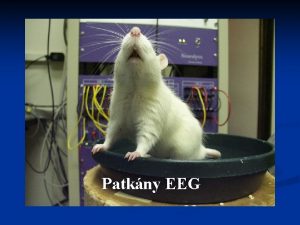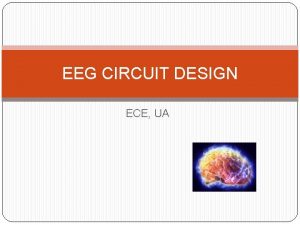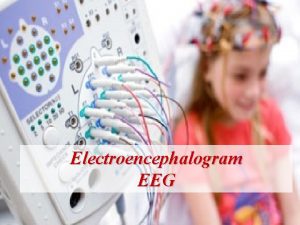EEG Monitoring System The EEG PortoCap Team 5


























- Slides: 26

EEG Monitoring System The EEG Porto-Cap™ Team 5 ENGN 4017 - Engineering Design Autumn 1999

Design Process March • Examine project domain – EEG measurement systems • Meet with intended customer – Dr Richard Clark, Flinders University SA • Identifying problems with existing skull cap system – Requirements for new system were formulated • Develop conceptual solutions to problems – Brainstorming • Project Decomposition – Sub-system groups focussing on specific problems • Integration – System integration June • Presentation, Final Report

What is EEG? • EEG = Electroencephalogram • Measurement of brain wave patterns in hopes of understanding the mysteries of the mind.

Problem Statement The reliable measurement, over extended periods, of scalp EEG on consecutive occasions, during mental functions in everyday environments.

Key Problem Areas Issues that needed to be addressed in any new system developed by the group: • • Lack of repeatability Different Head Sizes Long setup times Difficulty with lengthy experiments Use of conductive gels Scalp abrasion Noise in signal Lack of portability/environmental constraints In finding a solution, we have taken an ambitious approach to solving these problems in a medical research application

Problem Decomposition

Mechanical Key Requirements

Mechanical Cap Design

Mechanical Positioning • Nasion/Ear reference points • Adjustable straps for different head dimensions (53 cm - 66 cm) • Electrodes retractable to suit Nathan in an early model. Current model.

Mechanical Demonstration of Skull Cap Setup. . .

Electrode Key Requirements

Electrode Selection • Silver/silver chloride selected – Minimal polarisation characteristic • Dry electrode used (no gel required) – Uses local impedance converting amplifier • Pellet electrode, 2 mm diameter – Small electrode size ensures good hair penetration and contact with scalp 2 mm

Electrode Irritation Issues • Initial model- helmet supported by electrodes • Prototype - straps support the load – allows smaller electrodes to be used without increasing irritation – straps allow for more comfortable fit • No preparation or abrasion of skin surface required

Electrode Cleaning • Electrodes detachable for cleaning • Cleaning processes include disinfecting and sterilisation via autoclave • Use of two sets of electrodes allows continuous use

Signals Key Requirements

Signals Components

Signals Signal Flow

Signals Signal Flow

Signals Signal Flow

Signals Signal Flow

Other Features Signals • EMF Shielding – Faraday cage – Cable shielding • Auto-Zero Function – Remove constant DC offset introduce by electronic components

Areas of Further Research • • Gauging depth of electrodes Improving setup time Ag/Ag. Cl dry electrodes Electrode polarisation Effectiveness of Faraday cage Noise analysis Artifacts from physiological rhythms

Manufacturing Materials Cost • Total - around US$4 k – Mechanical - US$100 – Electrode - US$2300 – Signals - US$1800 • Prototype materials - estimated US$50 k

Why you should upgrade to the Porto-Cap™. . . ü Wireless communication – no huge cables to lug around, you are free to walk around the house just like with a cordless phone. ü Data recorded from each different electrode is clocked at exactly the same instant – at last, a device which accurately maps which bits of your brain that weren’t working during that embarrassing moment. ü No scalp preparation required – the feeling of blunt needles scraping your scalp will only be remembered in your nightmares. ü Porto-Cap™ uses dry electrodes only – that gooey conducting paste can now be used as axle grease. ü Zero signal drift – the amplifier and filter package has been hand picked so that the only interruptions during a testing period will involve rubble entering your building. ü Eight selectable sampling frequencies – if flexible data rates is you, then you won’t die hungry when wearing the Porto-Cap™.

Conclusion The EEG Porto-Cap™ successfully enables repeatable and reliable measurements of EEG signals. It achieves this with little discomfort, no paste or gel and in conventional environments.

Thank you for coming, we would like to take this opportunity to answer any questions you may have. Team 5 ENGN 4017 - Engineering Design Autumn 1999
 Going native project management
Going native project management Team spirit becomes team infatuation
Team spirit becomes team infatuation The white team cheers for the blue team, just like
The white team cheers for the blue team, just like Eeg eye
Eeg eye Eeg sweat artifact
Eeg sweat artifact Ne regional epilepsy group
Ne regional epilepsy group Eeg for dummies
Eeg for dummies Lateral rectus spikes eeg
Lateral rectus spikes eeg High frequency filter eeg
High frequency filter eeg Eeg procedure
Eeg procedure Eeg amplifier circuit
Eeg amplifier circuit Eeg bands
Eeg bands Eeg case study
Eeg case study Yüzey elektrotları
Yüzey elektrotları Signal amplitude of eeg
Signal amplitude of eeg Wicket rhythm eeg
Wicket rhythm eeg Gped map
Gped map Tuh eeg
Tuh eeg Myoclonic seizure symptoms
Myoclonic seizure symptoms Neuroinformatika
Neuroinformatika How does meg work
How does meg work Eeg results abnormal
Eeg results abnormal Cpt 95720
Cpt 95720 Contraindications for hyperventilation during eeg
Contraindications for hyperventilation during eeg Icp monitoring
Icp monitoring Hseep toolkit
Hseep toolkit Eeg
Eeg



